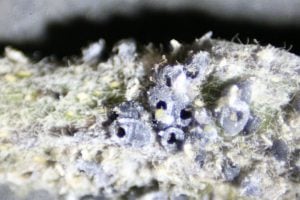At this time of year woolly apple aphid colonies will be starting to expand as crawlers emerging from overwintering sites on the roots, begin to establish on the shoots, and aphids in colonies that survived on branches over winter begin to multiply. The tiny wasp (A.Mali) parasitises woolly apple aphids by laying its eggs into the aphids, causing them to become ‘mummies’ in which the wasp larvae develop and eventually kill the aphid. Signs that A.mali is active are the presence of black mummies in amongst the aphid colony. If the mummies have a hole in them it means that the wasp has reached maturity and exited the mummified aphid. A.mali can be introduced into unparasitised woolly aphid colonies if you or someone you know already has it present in parts of an orchard.

Parasitised Woolly Aphid ‘mummies’ showing exit holes where the adult wasp (or woolly aphid parasitoid) has emerged. Presence of ‘mummies’ indicates the wasp is active in the orchard (Photo: K Dodds, NSW DPI)
To do so cut off wasp infested branches or twigs and then place them directly on top of the unparasitised woolly aphid colonies. Do not transfer branches or twigs if you can only see empty black mummified aphids with round holes at the top where the wasps have emerged; they will have moved onto other woolly aphid colonies.
It is possible to conserve the wasps by collecting infested branches or twigs early in winter, before spraying, and storing them in a coolroom (not in a freezer) until mid-spring. The branches or twigs can then be placed in trees showing signs of aphid infestation in early-mid spring.

Adult wooly aphid wasps (A.Mali) present on the underside of leaves (Photo: K Dodds, NSW DPI)
Article Reviewed by Kevin Dodds (NSW DPI)
